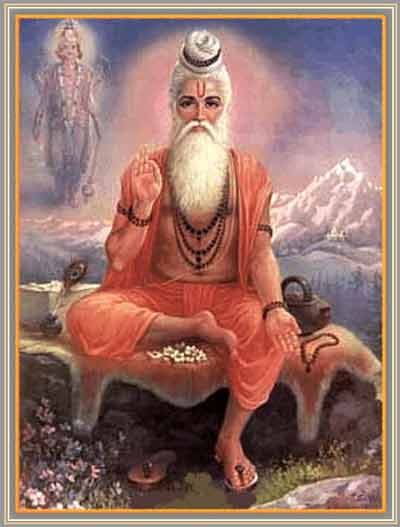At the end resides the dumb,
Where is Guru? Where is Brahman? There is nothing.
When the connection occurs where is the grace?
In the uncreated space there is none.
By waiting at the feet and discussing with the Siddhas,
(The aspirant) has the vision after crossing the mula;
And the five mountains (muvancu varai) comprehending the ultimate.
Then only he will be called the son of Agastya.
—Dhanvantri Jnanam (Verse 10, The Yoga of the 18 Siddhas: An Anthology, p. 471)
Yoga isn’t only about letting go of own false identification with what we are not but also remembering who we are at the ground of our being in
Self-realization and God-realization. The practice of self-remembrance may take many forms, for example, asking “Who am I?” or “Who is it that is
suffering?” and allowing these questions to turn our attention within.
The Yoga Siddhas prescribed a more direct method: concentrating on a point of light, known as bindu, or on the sacred syllable Aum,
particularly between the eyebrows, and then allowing our consciousness to expand. The result of this practice is the realization of vettaveli (vast, luminous space).
In seeking to inspire others to realize the Divine and to transform ignorant human nature, the Siddhas avoided any reference to a deity with a name, form,
or personality. Nowhere in the writings of the Siddhas do we find any references to gods, deities, or a divine personality. For the Siddhas, God is the
supreme abstraction, beyond name and form. To define God, or anything else for that matter, is to limit it. So, how can we limit with words what is
limitless? Nevertheless, the Siddhas sought to inspire others to realize the Supreme Being, through the practice of Kundalini Yoga, as vettaveli.
In the verse above by the Siddha Dhanvantri, “the dumb” refers to the mystical syllable Aum, implying that it can never be grasped as a concept or
through discussion but only in silence, which is unceasing eloquence. “The end” refers to the sahasrara chakra at the top of the head,
where there are no more relationships. The relationships between Guru and disciple and God and devotee end in union. “The uncreated space” refers to
vettaveli, the Siddhas’ favorite metaphor to describe the indescribable Absolute: vast, luminous space. It is an alogical whole not determined by
any set of relations. No amount of speaking can capture it, but we might realize it through the guidance of the Guru in the practice of Kundalini Yoga as
prescribed by the Siddhas.
In the next lines, Dhanvantri mentions the elements essential to realizing vettaveli: learning it in the person of the Guru (“at the feet”), awakening the
energy in the muladhara chakra and directing it mentally upward through the five higher chakras until it reaches the sahasrara chakra. Becoming one with
this Absolute Reality and enjoying its bliss, we deserve to be called the “son of Agastyar,” that is, belonging to the Siddha tradition of Agastyar.
Vettaveli represents the blissful samadhi state, the space of consciousness, of transcendental awareness, the awareness of Being itself. It is a “place”
where thoughts drop off one by one until our consciousness exists merely as an empty expanse. It stands for the absence of subjectivity and objectivity. It
stands for the escape from time. It is the eternal now. It is a state in which we transcend past, present, and future. It is a state not accessible to
sensuous perception, a state without distinctive marks, a stainless sky. Vettaveli is liberation and true freedom. Repeating the mantra va and si during pranayama, we realize the presence of Sivam, the Lord, in its static and dynamic modes, and the six chakras below open (referred to in
the verse above as the “mula” and “the five mountains”), revealing vettaveli, the open space, liberation. It is “that Truth, the sun lying concealed in the
darkness” of ignorance about which the Rigveda speaks: tat satyam suryam tamasi ksiyantam.
It is the source of creation, sustenance, dissolution, obscuration, and grace, the five functions of the Lord according to the Siddhas:
It is formless, blemishless,
Self-effulgent and omnipresent,
Ever-blissful, beyond expression, and
The inner light of those who have known it,
The One dividing itself into Brahma, Vishnu, and Siva
Creates, sustains, and destroys the whole universe.
Like a column of light that is Liberation, It is,
May the feet of the Godhead protect.
—Paambatticcittar (“Aphorisms of Wisdom,” Verse 1; The Yoga of the 18 Siddhas: An Anthology, pp. 475–76.

Siddha Boganathar
The Siddha Boganathar says:
There is nothing other than the all-embracing, everlasting eternal space.
Disconnect the affiliation of religions resulting in spiritual ignorance.
With bewilderment become one with the Absolute;
Experience and enjoy the celebrated nectar.
—Boganathar (“Astanga Yogam,” Verse 14; The Yoga of Siddha Boganathar, Volume 1, pp. 210–11)
Boganathar tells us that ultimately there is nothing but formless, blissful Consciousness – vettaveli. The word vettaveli is closely related to
the word bindu (point, seed, starting point), the concentrative starting point in the unfolding of inner space in meditation. Perhaps “religions”
refers to the image of the Supreme as a chosen form of deity, the choosing of which seems to separate the individual from God. It reflects an assertion
that even deep concentration or meditation on a deity will not lead to liberation. The final step must occur when images dissolve and deepest concentration
and meditation is on a formless Supreme Being. We find it within ourselves as effulgent self-awareness. With the eyes closed, concentrate on a point of
light between the eyebrows and experience That.